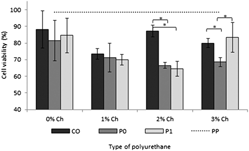Crossref Citations
This article has been cited by the following publications. This list is generated based on data provided by
Crossref.
Arévalo-Alquichire, Said
Morales-Gonzalez, Maria
Diaz, Luis E.
and
Valero, Manuel F.
2018.
Surface Response Methodology-Based Mixture Design to Study the Influence of Polyol Blend Composition on Polyurethanes’ Properties.
Molecules,
Vol. 23,
Issue. 8,
p.
1942.
Uscátegui, Yomaira L.
Díaz, Luis E.
Gómez-Tejedor, José A.
Vallés-Lluch, Ana
Vilariño-Feltrer, Guillermo
Serrano, María A.
and
Valero, Manuel F.
2019.
Candidate Polyurethanes Based on Castor Oil (Ricinus communis), with Polycaprolactone Diol and Chitosan Additions, for Use in Biomedical Applications.
Molecules,
Vol. 24,
Issue. 2,
p.
237.
Su, Qiulan
Wei, Dan
Dai, Weigang
Zhang, Yanhong
and
Xia, Zhengbin
2019.
Designing a castor oil-based polyurethane as bioadhesive.
Colloids and Surfaces B: Biointerfaces,
Vol. 181,
Issue. ,
p.
740.
Uscátegui, Yomaira L.
Díaz, Luis E.
and
Valero, Manuel F.
2019.
In vitro and in vivo biocompatibility of polyurethanes synthesized with castor oil polyols for biomedical devices.
Journal of Materials Research,
Vol. 34,
Issue. 4,
p.
519.
K., Saral Sarojini
M.P., Indumathi
and
G.R., Rajarajeswari
2019.
Mahua oil-based polyurethane/chitosan/nano ZnO composite films for biodegradable food packaging applications.
International Journal of Biological Macromolecules,
Vol. 124,
Issue. ,
p.
163.
Morales-Gonzalez, Maria
Arévalo-Alquichire, Said
Diaz, Luis E.
Sans, Juan Ángel
Vilariño-Feltrer, Guillermo
Gómez-Tejedor, José A.
and
Valero, Manuel F.
2020.
Hydrolytic stability and biocompatibility on smooth muscle cells of polyethylene glycol–polycaprolactone-based polyurethanes.
Journal of Materials Research,
Vol. 35,
Issue. 23-24,
p.
3276.
Huang, Yi-Jing
Chou, Ying-Nien
Lin, Yiu-Jiuan
Chen, Wei-Yu
Chen, Chuh-Yean
and
Lin, Hong-Ru
2021.
Polyurethane modified by oxetane grafted chitosan as bioadhesive.
International Journal of Polymeric Materials and Polymeric Biomaterials,
Vol. 70,
Issue. 15,
p.
1100.
Shokri, Mahshid
Dalili, Faezeh
Kharaziha, Mahshid
Baghaban Eslaminejad, Mohamadreza
and
Ahmadi Tafti, Hossein
2022.
Strong and bioactive bioinspired biomaterials, next generation of bone adhesives.
Advances in Colloid and Interface Science,
Vol. 305,
Issue. ,
p.
102706.
Cespedes, Jhoan F.
Arévalo-Alquichire, Said
Diaz, Luis E.
and
Valero, Manuel F.
2022.
Influence of Starch on the Structure–Properties Relationship in Polyethylene Glycol/Polycaprolactone Diol Polyurethanes.
Polymers,
Vol. 14,
Issue. 15,
p.
3184.
Zheng, Kaikai
Gu, Qinhao
Zhou, Dong
Zhou, Muran
and
Zhang, Lei
2022.
Recent progress in surgical adhesives for biomedical applications.
Smart Materials in Medicine,
Vol. 3,
Issue. ,
p.
41.
Hamedi, Hamid
Moradi, Sara
Hudson, Samuel M.
Tonelli, Alan E.
and
King, Martin W.
2022.
Chitosan based bioadhesives for biomedical applications: A review.
Carbohydrate Polymers,
Vol. 282,
Issue. ,
p.
119100.
Gorbunova, Marina
Grunin, Leonid
Morris, Robert H.
and
Imamutdinova, Arina
2023.
Nanocellulose-Based Thermoplastic Polyurethane Biocomposites with Shape Memory Effect.
Journal of Composites Science,
Vol. 7,
Issue. 4,
p.
168.
Ruiz, David
Uscátegui, Yomaira L.
Diaz, Luis
Arrieta-Pérez, Rodinson R.
Gómez-Tejedor, José A.
and
Valero, Manuel F.
2023.
Obtention and Study of Polyurethane-Based Active Packaging with Curcumin and/or Chitosan Additives for Fruits and Vegetables—Part I: Analysis of Morphological, Mechanical, Barrier, and Migration Properties.
Polymers,
Vol. 15,
Issue. 22,
p.
4456.
Senra, Elaine M.
Silva, Ana L. N.
and
Pacheco, Elen B. A. V.
2023.
A Review of Waterborne Polyurethane Coatings and Adhesives with Polyester Polyol from Poly(Ethylene Terephthalate) Waste.
Journal of Polymers and the Environment,
Vol. 31,
Issue. 9,
p.
3719.
Uscátegui Maldonado, Yomaira Lisnedy
Díaz Barrera, Luis Eduardo
Valero Valdivieso, Manuel Fernando
and
Coy-Barrera, Ericsson
2023.
Synthesis and characterization of polyurethane films based on castor oil-derived polyols with heparin and low-molecular-weight chitosan for cardiovascular implants.
Journal of Materials Research,
Vol. 38,
Issue. 13,
p.
3349.
Strzałka, Anna Maria
and
Lubczak, Jacek
2023.
Polyols and Polyurethane Foams Based on Water-Soluble Chitosan.
Polymers,
Vol. 15,
Issue. 6,
p.
1488.
González-Torres, Maykel
Elizalde-Cárdenas, Alejandro
Leyva-Gómez, Gerardo
González-Mendoza, Oswaldo
Lima, Enrique
Núñez-Tapia, Israel
Abad-Contreras, David Eduardo
Luisa Del Prado-Audelo, María
Pichardo-Bahena, Raúl
Carlos-Martínez, Alberto
and
Ribas-Aparicio, Rosa María
2023.
Combined use of novel chitosan-grafted N-hydroxyethyl acrylamide polyurethane and human dermal fibroblasts as a construct for in vitro-engineered skin.
International Journal of Biological Macromolecules,
Vol. 238,
Issue. ,
p.
124136.
Akbari Nasser, Mohammad Hossein
Tabbakhi-Mamaqani, Ahmad Reza
Lotfi Mayan Sofla, Reza
Rezaei, Mostafa
and
Salami-Kalajahi, Mehdi
2024.
Synthesis of diamond nanoparticles/urethane-based bio-adhesive and investigation of its morphology and thermal, physicomechanical, and biological properties.
International Journal of Polymeric Materials and Polymeric Biomaterials,
Vol. 73,
Issue. 10,
p.
908.
Emir Coban, Ozlem
Akat, Zelal
Karatepe, Pınar
and
Incili, Gökhan Kürşad
2024.
In vitro bioactivity of biodegradable films based on chitosan/quince seed mucilage reinforced with ZnO-nanoparticle.
Journal of Food Measurement and Characterization,
Vol. 18,
Issue. 7,
p.
5450.
Strzałka, Anna Maria
Dębska, Bernardeta
and
Lubczak, Jacek
2024.
Polyols and polyurethane foams based on chitosans of various molecular weights.
Journal of Applied Polymer Science,
Vol. 141,
Issue. 20,
